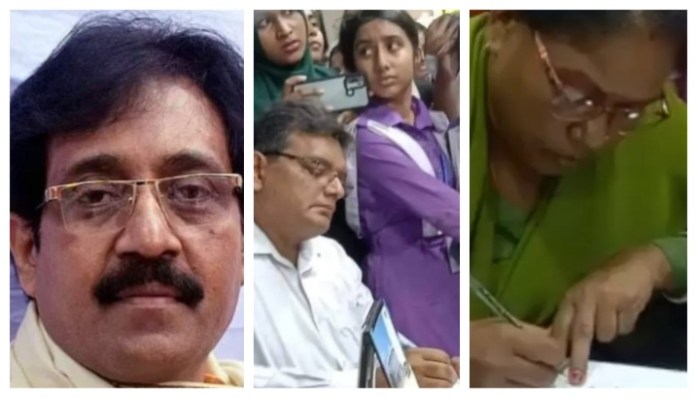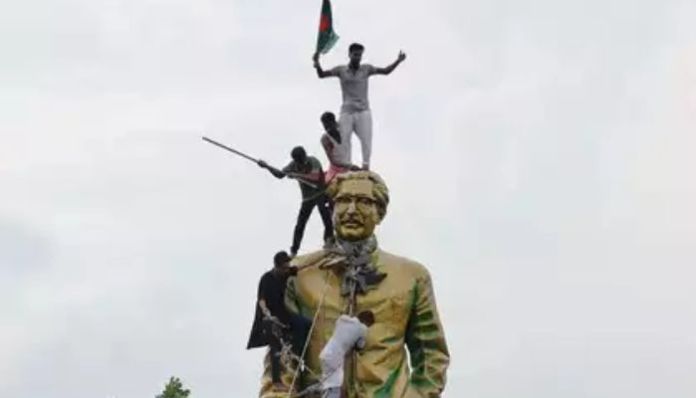
“Protestors take over the streets of Dhaka”. “Violent mob barges into Sheikh Hasina’s residence”. “Sheikh Hasina resigns”. “Prime Minister Sheikh Hasina forced to flee Bangladesh”. Such headlines dominated news on 5th August 2024, when ‘student’ protestors and Islamists from the Jamaat-e-Islami wreaked havoc in Bangladesh, unceremoniously ousting their elected Prime Minister Sheikh Hasina.
With Sheikh Hasina, political sanity and whatever little religious tolerance there was in Bangladesh also left, as minorities, especially Hindus, were looted, raped, killed, and their temples were destroyed with impunity. As the violent regime change in Bangladesh marks one year, here’s a timeline of what preceded the ouster of Sheikh Hasina and Bangladesh’s descent into chaos, rise of Islamism, and the persecution of Hindus.
Student protests or a regime change playbook successfully executed?
In early July 2024, protests erupted in Dhaka, led by the Students Against Discrimination movement. The sequence of events and Sheikh Hasina’s statements regarding attempts being made to destabilise Bangladesh and oust her from power illegally, fuel the speculation that the Awami League leader’s forced resignation and escape from her homeland was not simply a consequence of student protests but that of a US-orchestrated regime change operation.
The turmoil in Bangladesh started in early 2024 and centred on a contentious quota system for government posts. The Court’s decision to keep a sizable proportion of jobs for specific groups, notably descendants of freedom fighters and women, prompted great outrage among university students. It all started over the decision of the High Court to reinstate the 30% reservation in government jobs to the descendants of the freedom fighters of the 1971 Liberation War. What started as peaceful protests soon took a violent turn.
In the first phase of the protests, it was reported that over 32 people died while nearly 1000 were injured as the country was grappling with high inflation, dwindling foreign reserves, and rising unemployment. On the 18th of July 2024, the anti-quota protesters set fire to the headquarters of the state broadcaster Bangladesh Television (BTV) in Dhaka. The police had to fire rubber bullets and use other non-lethal weapons to quell the protests by the students, causing more deaths and injuries.
Notably, until 2018, 56% of government posts in Bangladesh were reserved for certain groups. These groups included people with disabilities (1%), indigenous communities (5%), women (10%), people from underdeveloped districts (10%), and families of freedom fighters from the 1971 Bangladesh Liberation War (30%).
With this arrangement in force, there were only 44% of seats open to merit-based selection. In 2018, student groups staged large-scale protests, forcing the Sheikh Hasina-led government to scrap the entire quota system.
In June 2024, the High Court of Bangladesh overruled the government’s decision, which triggered further demonstrations by student groups.
The Supreme Court’s Appellate Division upheld the High Court’s decision on the 4th of July triggering widespread protests. After Sheikh Hasina’s appeal, the Bangladeshi apex court directed all petitioners to maintain the status quo till the 7th of August 2024.
During the second phase of the nationwide protests, it was reported that over 150 people were injured, and two people had died. This came just two weeks after the country’s Supreme Court reduced the percentage of reserved government jobs from 56% to 7%. Initially, the anti-quota protestors sought revocation of reservation for families of freedom fighters. However, they then renewed their demands and sought “justice” for the 200 odd-people who were killed during the initial phase of violent protests and immediate release of detained protestors.
In Dhaka, Khulna, Sylhet, Narsingdi, Chattogram and Noakhali, after Jumma Namaz, numerous incidents of violence were reported. The protestors set a police box on fire at the Wasa intersection in Chattogram after Jumma Namaz. The protestors resorted to pelting stones and hurling brickbats. The law enforcement authorities responded with lathi-charge, rubber bullets, firearms, stun grenades and teargas. Several protestors who sustained rubber bullet injuries were admitted to hospitals.
On 18th July 2024, PM Hasina called in the army to manage the escalating protests and violence.
In an attempt to quell the protest, the authorities suspended all internet services, including broadband, banned all Meta platforms, including Facebook, WhatsApp, Messenger, and Instagram, and announced a three-day vacation.
Amidst the violence and anarchy, the protestors demanded the resignation of Prime Minister Sheikh Hasina. By 4th August, over 100 people had died in the clashes between the Awami League supporters and the protestors. The deceased included 14 police personnel. In the wake of the violence in Bangladesh, the Interior Ministry declared a nationwide curfew to try and control the law and order. The government also declared a holiday between 5th and 7th August to pacify the situation.
As Asif Mahmud, heading the ‘Student Movements Against Discrimination’, appealed to protestors to march in Dhaka on the 5th of August, a massive number of people arrived in Dhaka. The protesters started their “Long March to Dhaka” with one sole aim: to oust Sheikh Hasina from power.
Jamat-e-Islami, BNP and the escalation of violent protests
While protests turned violent as conflicts between protestors and police became frequent, the violence worsened when the Jamaat-e-Islami (JeI) and the Bangladesh Nationalist Party (BNP) started to magnify the mayhem, using it to undermine the ruling Awami League government. The inclusion of these opposition parties intensified the severity of the protests, as their supporters joined the fray.
The impact of JeI and BNP on the uprising is not hidden. Both parties saw the protests as an unmissable strategic opportunity to undermine Hasina’s government. They allegedly offered logistical support and mobilised their bases, resulting in larger and more organised protests. Their involvement transformed a student-led demonstration into a larger anti-government campaign. Notably, the BNP has been at the forefront of a vicious anti-India “India Out” campaign calling for the boycott of Indian goods. As PM, Sheikh Hasina had strongly opposed the BNP’s anti-India propaganda.
In an attempt to placate the fury, Bangladesh’s Supreme Court delivered a crucial decision, annulling the quota ruling. However, the judicial intervention proved insufficient to solve this issue. The protestors, now supported by the JeI and BNP, continued their rallies, seeking larger reforms and accusing the Hasina government of corruption and ‘dictatorship’.
Sheikh Hasina’s unceremonious and illegal ouster marked the end of an era
Finally, on the 5th of August 2024, Sheikh Hasina resigned from the post of Prime Minister, ending her 15 years in power. She left for New Delhi in a military chopper after resigning. Ironically, Sheikh Hasina, who once saved Bangladesh from military rule, was compelled to resign after the country’s army gave her just 45 minutes to resign and leave.
Soon after, countless violent protesters, carrying flags and celebrating in jubilation, with some even dancing atop tanks, breached the gates of Hasina’s official residence after she fled the country amid ongoing protests. In what emerged as the most disgraceful image of the anti-Hasina protests was of Islamist mobs ransacking Hasina’s residence and flashing her undergarments on 5th August 2024.
Months before her resignation, Sheikh Hasina had alleged that the United States is attempting regime change in Bangladesh via the opposing BNP and Jamat-e-Islami. Last year, the US also extended support to the Islamist Bangladesh Nationalist Party (BNP) and its ally Jamaat-e-Islami during its protests against the PM Hasina-led government. In September 2024, Sheikh Hasina accused the United States of orchestrating her removal from the post of PM because she refused to hand over Saint Martin Island to the US, which would have enabled the western superpower to have “sway over the Bay of Bengal”.
In her statement, she said, “I resigned so that I did not have to see the procession of dead bodies. They wanted to come to power over the dead bodies of students, but I did not allow it; I resigned from the premiership. I could have remained in power if I had surrendered the sovereignty of Saint Martin Island and allowed America to hold sway over the Bay of Bengal. I beseech the people of my land, ‘Please do not be manipulated by radicals.”
Following Hasina’s ouster, violent Jamaatis and other Islamists attacked Awami League leaders, government officials they accused of being pro-Hasina and singled out Hindu officials for their religious identity and assaulted, humiliated and forced them to resign. On 5th August alone, over 119 people, including 25 police officials, were killed by the violent mobs.
While Sheikh Hasina took refuge in India, Bangladesh fell into the hands of Islamists and violent Jihadis, and then began the persecution of Hindus and other religious minorities in the country, which continues till now.
On one hand, Islamists were looting Hindu houses, raping Hindu women, killing Hindu men, and desecrating Hindu temples; on the other, they were wiping out the legacy of “Bangabandhu” Sheikh Mujibur Rahman, pissing on his statue and the sacrifices of the Bengali freedom fighters. This wiping out of Bangladesh’s founding father’s legacy and persecution of Hindus made the country’s pivot towards full-fledged Islamisation evident and inevitable.

In Meherpur, an ISKCON temple was vandalised by jihadist mobs and idols were smashed on 5th August 2024. Meherpur ISKCON Temple’s spokesperson, Sumohan Mukunda Das, had back then said that the current situation for Bangladeshi Hindus is akin to how it was in the 1970s. He said that Hindu politicians, traders and Mandirs were being targeted by the Islamist mobs. On just 5th August, more than 54 attacks on Hindu temples, houses and establishments were carried out by Islamist mobs.
Hindu temples were targeted in Natore, Dhamrai in Dhaka, Kalapara in Patuakhali, Shariatpur, and Faridpur, as well as houses in Jessore, Noakhali, Meherpur, Chandpur, and Khulna. Dinajpur saw the vandalisation of 40 Hindu shops. In addition, one Ahmadiyya mosque in Taraganj, Rangpur, was attacked and vandalised. Gplus reported how Muslim mobs looted Hindu houses, stole cattle and jewellery, demanded money, read Jizya, to spare their lives.
Such attacks were unleashed on Hindu houses and shops in Sultannagar, Monirampur and Khatuadanga market, Dhalgram Union, Bagharpara Upazila and other areas. In Noakhali’s Hatiya, three houses and four shops of the Hindus were attacked, vandalised and plundered. In Dhaka’s Dhamrai, a mob comprising 100 to 150 people marched and attacked the house of local Meena Rani Das in the Barbaria area of Gangutia Union. In Lalpur in Natore, around six houses, including the house of the Puja Udyapan Parishad president and a temple, were vandalised and plundered. n Dinajpur, at least 40 Hindu-owned shops were vandalised and robbed in the Chowrangi market of the Isania Union of Bochaganj Upazila.
In Chandpur, the Muslim mob attacked the house of Puranbazar Degree College Principal Ratan Kumar Majumdar in the city’s Adalt Para, and the house of Gallak Adarsh Degree College Principal Haripad Das in Faridganj was attacked, vandalised, looted and set ablaze. In Shariatpur, a temple in Dhanuka Mansa house was attacked. The Muslim mob broke the idol of Lord Krishna and fled the spot. Similarly, in Khulna, 11 Hindu houses were attacked in different unions of Dakop Upazila
While numerous temples of Maa Durga, Maa Kali and other Hindu deities were destroyed across Bangladesh while Indian Islamo-leftist media spun the ‘Muslims forming human chain to save Hindu temples’ narrative.
These are just a few reported incidents during the initial phase of the jihadist onslaught against Hindus in post-Hasina Bangladesh. Hindus sought help from the police and army; however, their wails and cries for help fell on deaf ears, and their persecution continued unchecked.
Gplus reported numerous verified incidents of target attacks by Muslim mobs on Hindu temples and Hindu houses. While there have been incidents wherein the mob targeted Hindu leaders of the Awami League, the attacks are not confined to political rivalries or revenge. While attacks on Hindu temples themselves make it evident since temples don’t have any political affiliation but are simply the abode of Hindu deities, Hindus, regardless of their political leanings, were singled out and attacked.
The Bangladesh Hindu Buddhist Christian Unity Council reported 205 incidents across 52 districts by August 15, including 190 cases of looting, 32 homes set on fire, 16 temples desecrated, and two rape cases.
Speaking to Gplus, several Bangladeshi Hindus said that Jamaat-e-Islami members had prepared a list of Hindu businesses and Hindu houses since the fall of Sheikh Hasina. In one of the most horrifying incidents, Islamists encircled a dead victim lying on the ground while several men were gathered around the deceased. With the aid of a stick, one of the Islamists strips the deceased person naked and checks the victim’s private part for circumcision. The happiness of the Islamist had no bounds, and he started shouting ‘Hindu, Hindu’ over the corpse. The crowd hovering over the dead body laughed, realising that the man was a Hindu because he was not circumcised.
Foreign media tries to whitewash the Islamist violence and persecution of minority Hindus
It must be recalled how the foreign media, especially Qatar state-owned Al Jazeera, New York Times, BBC, DW, CNN as well as Indian lslamo-leftist propaganda outlets like TheWire, Scroll, among others, contextualised Islamist violence in Bangladesh and also tried to whitewash their crimes. In their reportage of the anti-Hindu onslaught, these propaganda outlets attempted to downplay the Islamic jihadist nature of the attack against Hindus for their religious identity and pass it off as mere political retribution for supporting Sheikh Hasina’s party, Awami League. Gplus, however, countered the falsehoods peddled by these outlets on multiple occasions and questioned how destruction of Hindu temples can be called ‘political revenge’, not Islamic jihadist hatred for Hindus on display.
After President Muhammad Shahabuddin dissolved parliament on 6th August and paved the way for an interim government, Nobel laureate Muhammad Yunus, whom Sheikh Hasina once called a “blood sucker”, was picked as Chief Advisor. While initially, Yunus emphasised preserving human rights and not targeting minorities, he too changed tunes and began downplaying anti-Hindu violence and blamed India and Indian media for exaggerating minority persecution in Bangladesh, in addition, projecting the government as Islamist radicals. This came after India raised concern over blatant violations of human rights and targeted attacks on Hindu and other religious minorities.
By September-October 2024, over 2000 attacks on Hindus across 45 districts in Bangladesh were documented by several minority rights groups in the country. The religious persecution of minorities by the Muslim majority sparked global outrage and protests in many countries.
In addition to mob violence, rape, loot, arson, and temple vandalism, Islamists in Bangladesh also harassed Hindu intellectuals and professionals and forced them to resign from their jobs. Some are also being pressured to leave Bangladesh solely because of their religious identity. In August 2024, it was reported that as many as 60 teachers/professors/govt officials, who are Hindus, were forced to resign. In many cases, these Hindu officials were surrounded by mobs, slapped, forced to wear garlands of shoes, and black ink rubbed on their faces.

In November 2024, ISKCON monk Chinmoy Krishna Prabhu, aka Chinmoy Krishna Das Brahmachari, who was also the spokesman of BSSJJ, was arrested by the Bangladesh Government in November on charges of sedition since he was leading the protests demanding security and protection of Hindu minorities in Bangladesh. His arrest sparked outrage among Bangladeshi Hindus, who took to the streets to demand his release. Meanwhile, India also registered a strong protest over the Hindu monk’s arrest on bogus charges. Despite his illness, Das was allegedly mistreated in prison. Months later, Das was granted bail by a high court; however, the Islamist regime continues to hound him with several other cases, since Das has been a fierce voice of Hindus.
Under Yunus’s watch, the banned anti-India and Islamist outfit Jamaat-e-Islami was unbanned, Islamist leaders were released from jail, while the crackdown on Awami League leaders intensified. The Yunus-led Islamist interim government targeted intellectuals who raised concerns over the persecution of Hindus. In the same vein, on 9th July 2025, Abul Barkat, a renowned Bangladeshi economist, was arrested from his residence in Dhammondi area. He was implicated by the authorities in an alleged corruption case. In November 2016, Abul Barkat wrote a book titled ‘Political economy of reforming agriculture-land-water bodies in Bangladesh.’ He warned that if the rate of exodus of the minority Hindu community continued, then there would not be any Hindus left after 30 years, i.e. 2046.
Rape, killing and human rights violations have become a new normal in Bangladesh
Under Yunus’s rule, 2.81 lakh rape complaints were made in less than a year. It was reported that there has been a significant rise in cases of sexual violence in madrassas by Islamic clerics.
The recent brutal rape of a Hindu woman in Muradnagar in Cumilla by BNP leader Fazor Ali and subsequent attempts to character assassinate the victim left the minority Hindu community of Bangladesh in a state of shock and trauma.
In March 2025, the Human Rights Support Society (HRSS) published its report exposing the deteriorating law and order situation in Bangladesh. The report revealed the grim human rights situation in Bangladesh. Human rights violations highlighted by HRSS include mob lynching, extrajudicial killings, political violence, child abuse, harassment of women and journalists and attempts to suppress freedom of speech. It also highlighted an atmosphere of anxiety and fear among the common people due to an increase in crimes such as murders, rapes, extortion, theft, snatching, and robbery.
The human rights body reported that at least 9 people were killed and 755 others were injured in political violence in February. A total of 104 incidents were found by HRSS for the same period. HRSS also reported 10 deaths and 13 injuries in 17 different incidents of mob violence. It also pointed out that at least 107 children and women were tortured. 53 (comprising 38 children) of them were subjected to brutal rape.
On 12th February 2025, the Office of the United Nations High Commissioner for Human Rights (OHCHR) published a 104-page report detailing atrocities committed against vulnerable Hindu minorities in Bangladesh. The report titled ‘Human Rights Violations and Abuses related to the Protests of July and August 2024 in Bangladesh.’ Its publication becomes crucial since the interim government in Bangladesh, led by Muhammad Yunus, is pandering to Islamists.
The findings of the OHCHR expose the grim reality that Muhammad Yunus tried to brush under the carpet. He has largely remained a ‘mute spectator’ to targeted attacks aimed at erasing the history of the Awami League in the context of Bangladesh’s independence and politics.
Bangladesh is witnessing a drastic rise in vigilante Muslim mobs, unleashing violence under the pretext of protecting the tenets of Islam. These mobs are largely unorganised but they call themselves ‘Tawhidi Janata (meaning Revolutionary People).’
From LGBTQ patron to appeaser of Islamic extremists: Muhammad Yunus became the supporter and enabler of Islamism in Bangladesh
Bangladesh witnessed a drastic rise in Islamism and anti-India sentiment after Yunus came to power. He first revoked the ban on the radical Islamist outfit ‘Jamaat-e-Islami.’
Thereafter, he released the leader of the radical outfit ‘Ansarullah Bangla Team (ABT)’, Muhammad Jasimuddin Rahmani.
At the same time, Muhammad Yunus downplayed the targeted attacks on the Hindu community by violent Muslim mobs. He has gone on record, from lamenting about attacks on Hindus to saying that the claims of atrocities are ‘exaggerated‘.
In that way, the controversial US asset was able to placate Islamic extremists. Given that the Awami League was against Islamism, the interim government first banned its student wing, ‘Chhatra League,’ and then the parent party.
Under the watch of Muhammad Yunus, Bangladesh saw a drastic rise in vigilante Muslim mobs, which unleashed violence under the pretext of protecting the tenets of Islam.
These mobs were largely unorganised and called themselves ‘Tawhidi Janata (meaning Revolutionary People).’ They came under the spotlight over acts of vandalism and harassment of people.
The Yunus regime introduced new textbooks for primary and secondary students, which falsely claimed that the first declaration of independence of Bangladesh was made by Ziaur Rehman (a favourite icon of Muslim hardliners in Bangladesh).
The interim government also appointed a Hizb ut-Tahrir terrorist named Mohammad Azaz as the administrator for the Dhaka North City Corporation (DNCC).
The situation had become so grim that Bangladeshi ambassador to Morocco Mohammad Harun Al Rashid was forced to slam the Muhammad Yunus-led interim government in a scathing Facebook post in March this year.
Islamist leaders and ex-army officials like Fazlur Rahman publicly made anti-India remarks, with some even daydreaming about capturing India’s northeast states. Similarly, an ‘adviser’ to the Muhammad Yunus-led interim government of Bangladesh named Mahfuz Alam had threatened to capture India on the occasion of Vijay Diwas on 16th December 2024.
In June this year, Muhammad Yunus made an audacious attempt to shift blame onto New Delhi for strained Indo-Bangladesh relations. Speaking at the Chatham House in London, Yunus also dared to villainise Prime Minister Narendra Modi for not heeding his request to stop Sheikh Hasina from making online speeches and comments, as she resides in India.
When asked about Bangladesh’s appeals to India to extradite Sheikh Hasina to face the court, Yunus said that these efforts will continue. He added that Bangladesh wants the best relations with India; however, it is the Indian media backed by the Modi government that runs fake news about Bangladesh, which makes matters worse. Yunus and others in power in Bangladesh have also been discrediting India’s role in the 1971 Liberation War that led to the creation of Bangladesh, even as, without the intervention of the Indian Armed Forces, the break-up of East Pakistan from West would never have been possible for the Bengali freedom fighters.
Recently, Muhammad Yunus was upset with Gplus for not downplaying and whitewashing Islamist violence against Hindus by coming up with ‘Muslim human-chain protecting Hindu temples’ sort of falsehoods, and instead reporting facts. On 22nd May, another violent act was perpetrated against the marginalised community when a Muslim crowd executed arson attacks on Hindu residences in Dahar Mashihati village, located in the Abhaynagar upazila of Jessore district in Bangladesh.
Predictably, the regime of Muhammad Yunus published a long post on X to downplay the communal nature of the crime. However, having realised that his post aimed at negating the Gplus report exposed his own Islamist nature, the ‘chief advisor’ to the interim government of Bangladesh deleted his controversial tweet.
In May 2025, Through one of his stooges, Mahmudur Rahman Manna (Nagorik Oikya party President), Yunus sent out a message that Bangladesh was faced with a ‘major crisis due to Indian hegemony’.
In April this year, Yunus claimed that Bangladesh is the guardian of ocean access for India’s Northeast states, and these states, landlocked and with limited connectivity, should be used as an extension of China’s economy. Following the undemocratic ouster of Sheikh Hasina, he made similar controversial claims about India’s seven sisters (Tripura, Assam, Arunachal Pradesh, Mizoram, Manipur, Nagaland and Meghalaya). “If you destabilise Bangladesh, it will spill over all around Bangladesh, including Myanmar and the seven sisters in West Bengal everywhere,” he claimed in August 2024.
The saga of the persecution of Bangladeshi Hindus, which began on 5th August 202,4 continues unabated even after a year
Anti-Hindu violence, anti-India rhetoric and Islamist hegemony have become an opprobrious reality of Bangladesh sans Sheikh Hasina. It’s been a year since the Awami League leader was forced to flee her homeland, and the country is yet to return to normalcy. Hindus are still being attacked, looted, raped and lynched, for simply being Hindus by Islamists, while their enablers in power show more dexterity in silencing those who report these incidents than acting against the Jihadi perpetrators.
On 28th July 2025, a Muslim mob comprising 400-500 Islamists attacked over 15 Hindu homes and carried out looting and vandalism under the pretext of ‘blasphemy’ in the Betgari Union in Gangachara upazila in Rangpur district of Bangladesh. Unsurprisingly, none of the Islamist perpetrators were arrested by the police. Gplus had previously highlighted 13 cases where Hindus were attacked, tortured and persecuted by Muslim mobs under the pretext of ‘blasphemy.’
One year after Sheikh Hasina’s ouster, Bangladesh remains mired in instability, with the Yunus-led government failing to address persistent issues. The country, which was doing reasonably well under PM Hasina, now has its economy in shambles. The persecution of Hindus, with documented attacks on houses, temples, and businesses, continues at the hands of Islamists who enjoy the unannounced support of the Islamist regime. While elections are to be held in Bangladesh next year, there is not much hope for Hindus and minorities since Islamist forces are dominating the socio-political discourse in the country and muzzling the voice of minorities.
















































